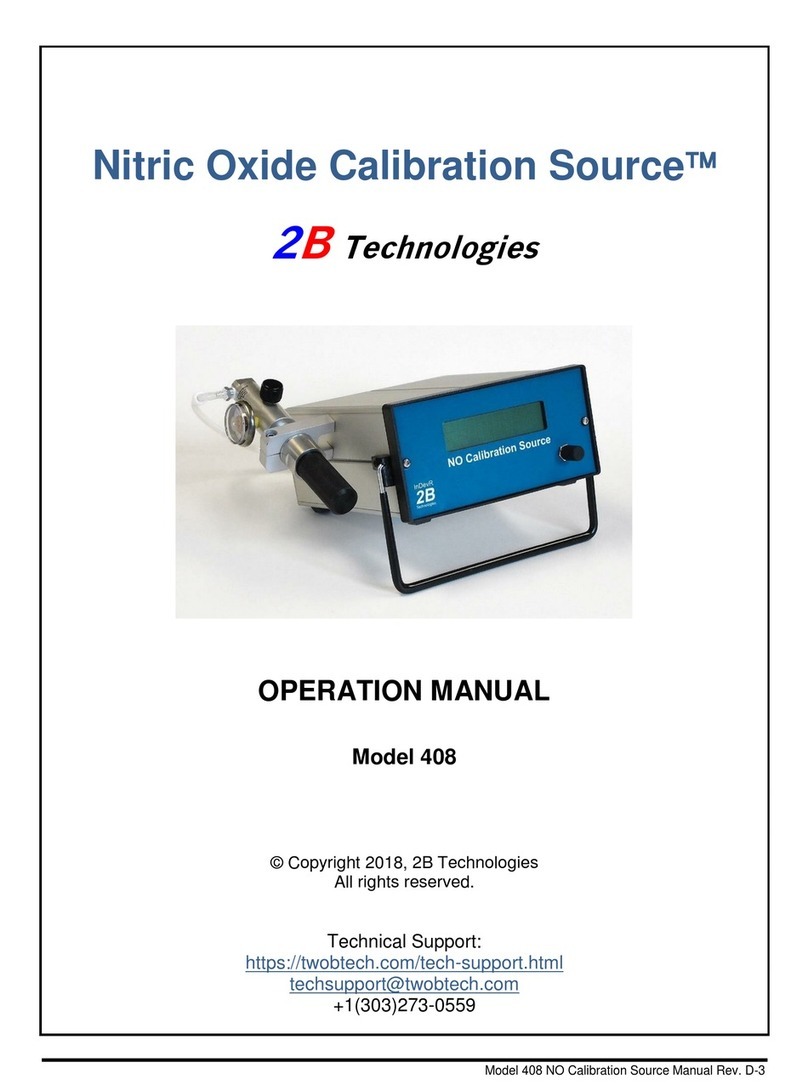Model 306 Ozone Calibration Source Manual Rev. G-1
1
1. INTRODUCTION
The Model 306 Ozone Calibration Source™(OCS™) is a portable source of ozone
that allows one to calibrate any ozone monitor, or to supply a calibrated source of
ozone for experiments such as exposure studies. It has been described in a peer-
reviewed publication in the journal Atmospheric Measurement Techniques (11, 4797-
4807, 2018; https://twobtech.com/2018_AMT_O3_Calibration_Source.pdf). Major
features of the Model 306 are:
•The instrument scrubs ozone from ambient air and produces either zero air or air
having a mixing ratio of ozone in the range 30-1,000 parts-per-billion by volume
(ppbv). The desired ozone concentration is chosen from the easy-to-use LCD
menu using a rotary select switch, or from a serial connection.
•The instrument can be programmed to output up to 10 individual ozone step
concentrations over a chosen time interval, for uses such ascalibrating ozone monitors.
•The instrument has a scheduler feature for once-daily automated execution of the
step program, at the user-specified hour.
•The total output volumetric flow rate is 4.0 L/min.
•The ozone mixing ratio is controlled so as to be independent of ambient
temperature, pressure, and humidity.
•A three-way valve in the Model 306 OCS™allows the user to switch their ozone
monitor easily from air sampling mode to calibration mode.
The Ozone Cal Source™output may be connected directly to the inlet of any ozone
monitor (provided that the ozone monitor’s sampling rate is less than 4.0 L/min); the
excess flow is vented through an ozone scrubber internal to the OCS™. Besides
portability, an important advantage of the Model 306 OCS™is that it provides a
known concentration of ozone in ambient air containing the same level of humidity as
the air sample to be measured.
The Ozone Cal Source™is factory calibrated against a NIST-traceable ozone
standard. However, the calibration parameters may be changed in the menu in case
the user wants to recalibrate the OCS™against a separately maintained standard;
i.e., the Ozone Cal Source™can be used as a transfer standard. The OCS™may be
used, for example, for maintaining the calibration of a large number of ozone monitors
in the field relative to a highly stable laboratory instrument. In this case, a huge
advantage of the OCS™is its portability.
Besides its use as a calibrator of ozone monitors, the Ozone Cal Source™may be
used as a calibrated ozone source for studies of the effects of ozone on materials
(rubber, plastics, paints, etc.) and on biological organisms such as plants.
1.1 Theory of Operation
The portable Ozone Calibration Source makes use of a low-pressure mercury lamp to
photolyze oxygen and produce ozone. The vacuum UV lines near 185 nm are




























